Lens options
Canon offers 55 EF lenses, which cover
full-frame sensors. These range from an 8-15mm fish eye zoom and a 14mm
super-wide-angle to an 800mm super telephoto. There are also four manual-focus
TS-E tilt-shift lenses and several macro lenses, including the MP-E 65mm //2.8
l-5x, as well as 1.4X and 2X teleconverters.
Nikon offers 59 lenses that cover the
full-frame format, from a 14mm super-wide-angle to a 600mm super telephoto.
There are also three manual-focus, perspective control (PC-E) lenses and
several 1:1 macro lenses, as well as 1.4X, 1.7X and 2X teleconverters.
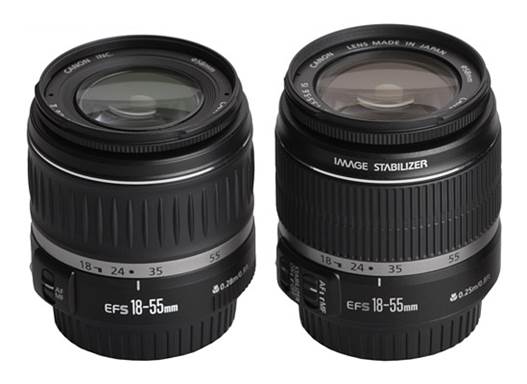
Canon
EF-S 18-55mm f/3.5-5.6
Sony offers 20 lenses that cover
full-frame, from a 16mm super wide-angle to a 500mm super telephoto, including
full-frame fisheye and 1:1 macro lenses. There are also 1.4X and 2X
teleconverters. Sony DSLRs can use legacy Konica Minolta Maxxum lenses, too.
Canon, Nikon and Sony also offer some
lenses that were designed specifically for the smaller APS-C sensors, and these
won't cover a full-frame sensor. Canon's EF-S lenses can't even be mounted on
full-frame DSLRs.
Nikon's DX and Sony's DT lenses can be
mounted on full-frame DSLRs, but when they are, the camera automatically crops
to APS-C format (with a corresponding loss of angle of view and pixel count).
It's best to use full-frame lenses on full-frame cameras, but in the case of
Nikon and Sony, it's nice to be able to use your APS-C lenses when moving up to
full-frame.
Video
Canon's EOS 5D Mark II (introduced in Fall
2008) was the first full-frame DSLR to do video, and it started a DSLR video
revolution as pros began using the Mark II for TV and movie work, as well as
still photography. (Nikon's APS-C D90, introduced just before the 5D Mark II,
was the first HD DSLR, but was limited to 720 I ID.)
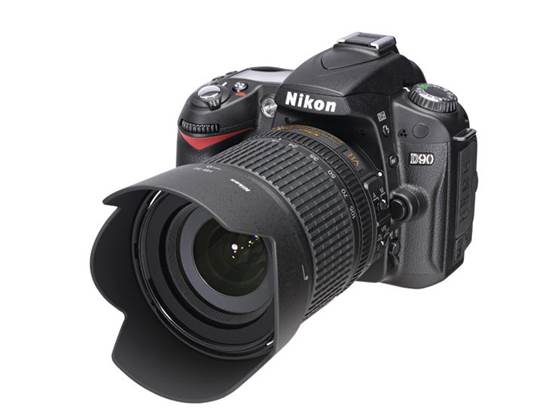
Nikon
D90
Today, all current full-frame DSLRs except
the Nikon D3X (also a 2008 model) can do 1080 full I ID video. The primary
benefits of full-frame DSLRs for video are the narrower depth of field possible
with the bigger sensors (which makes possible that film-cinematic
selective-focus effect not possible with smaller-sensor camcorders) and better
high-ISO image quality. I IDSLRs are also compact and relatively inexpensive
compared with pro motion cameras.
With Canon's video DSLRs, you can use
contrast or phase-detection AF before you begin shooting, but focus changes
during shooting must be done manually.
Nikon's full-frame video DSLRs offer
full-time, contrast-based AF while shooting, but it's too slow for many action
situations. Sony's SLT-A99, with its unique nonmoving translucent mirror,
permits quick continuous phase-detection at all times, for still and video,
with eye-level viewing via the built-in OLED electronic viewfinder, which makes
it the best bet if you want to do videos of action.
Bear in mind that with all systems, camera
noises, including autofocusing, will be picked up by the built-in microphone,
so it's best to use an external mic. All of the full-frame DSLRs have a socket
for an external stereo mic. On pro movie shoots, focusing is generally done
manually, and manual focusing during shooting can be done with all
video-capable DSLRs.
Canon EOS 6D
Canon's lowest-priced, full-frame model,
the 20.2-megapixel LOS 6D lists for $2,099, but nonetheless contains a
Canon-produced CMOS sensor and DIGIC 5+ processor that yield (according to
DxOmark.com) a tie with the flagship EOS-ID X for best overall image quality of
any EOS DSLR. The 6D can shoot full-res images at up to 4.5 fps, and has a
normal ISO range of 100-25,600, expandable to 50-102,400.
The 6D features built-in Wi-Fi and GPS. A
big pentaprism viewfinder shows 97% of the actual image area, and the 3.0-inch,
1040K-dot LCD monitor provides easy live viewing. While there's no built-in
flash, the 6D provides E-TI L II flash with compatible Canon Speedlites.
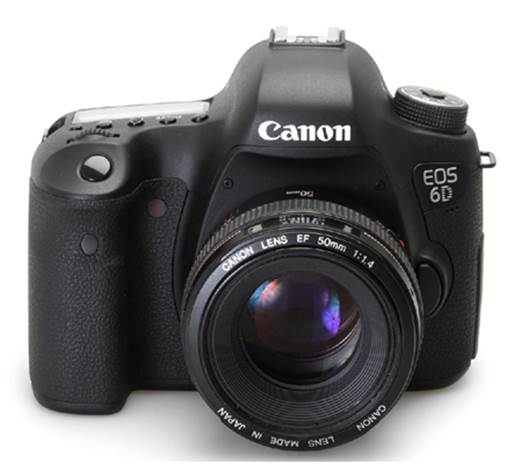
Canon
EOS 6D
Compact for a full-frame DSLR, the 6D
measures 5.7x4.4x2.8 inches and weighs 24.0 ounces. It has a single memory-card
slot, accepting SD, SDHC and SDXC media, including UHS-I units. Canon states
the 6D has "enhanced dust and weather resistance." The shutter is
rated at 100,000 cycles.
Nikon D600
Nikon's 24.3-megapixel D600 features EXPEED
3 processing and the third best overall score of any camera on DxQmark.coms
sensor ratings (trailing only Nikon's 36.3-megapixel D800E and D800). It can
shoot full-res images at up to 5.5 fps, and has a normal ISO range of 100-6400,
expandable to 50-25,600.
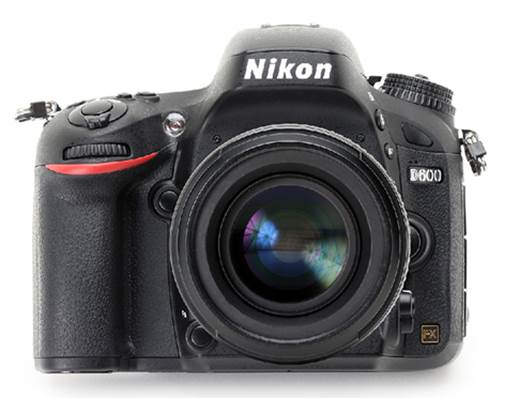
Nikon
D600
The big pentaprism viewfinder shows 100% of
the actual image area, and is complemented by a 3.2-inch, 921K-dot LCD monitor.
The built-in flash provides i-TTL flash control, as do compatible optional
external Speedlight flash units. The camera offers GPS and Wi-Fi via optional
accessories Dimensions are a compact 5.6x4.4x3.2 inches and 26.8 ounces. Dual
memory-card slots accept SD/SDHC/SDXC media, plus UHS-I compliance. The D600
features extensive weather-sealing, providing dust and moisture protection
equivalent to that of the D800/D800L cameras. The shutter is rated at 150,000
cycles.
Sony SLT-A99
Sony's 24.3-megapixel SLT-A99 brings the
benefits of the company's Translucent Mirror Technology (TMT) to the full-frame
format. Instead of the complex moving-mirror system used on other DSLRs, Sony's
SIX cameras use a translucent fixed mirror that transmits light to both image
sensor and phase-detection AF sensor simultaneously. So, there's no mirror
vibration, and you get full-time, phase-detection continuous AF in Live View
and Movie modes. Additionally, SteadyShot provides image stabilization with any
lens.
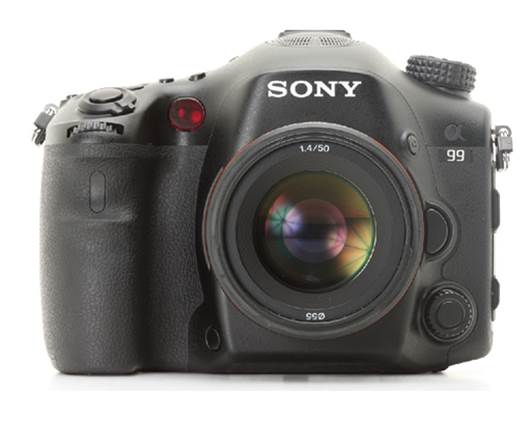
Sony
SLT-A99
DxOmark.com hasn't tested the A99's sensor
as of this writing, but it's similar to the one in Nikon's D600, so results
should be comparable perhaps a bit lower due to the light lost to the TMT
mirror. The A99 can shoot full-res images at 6 fps with continuous AF and 10-
megapixel APS-C images at 7 fps (8-10 fps in Tele Zoom Continuous Advance
Priority mode). Normal ISO range is 100- 12,800, expandable to 50-2,6O 0. With
the TMT system, the Sony SIJ-A99 has an 0110 Tru-Fincler instead of a typical
DSI.R optical viewfinder; that’s the same unit used in the SLTA77—a really good
one that permits eye-level viewing for video, as well as still shooting. A
3.0-inch, 12291<- dot LU) monitor tilts in almost any direction for easy
odd-angle shooting. The rugged, compact body (5.6*4x4*3.1 inches, 25.8 ounces)
is sealed against dust and moisture (although the manual says not to use the
camera in the rain). The shutter is rated at 200,000 cycles. You can use SD/SD
I IC/SDXC and Sony Memory Stick PRO/PRO-HG Duo media.